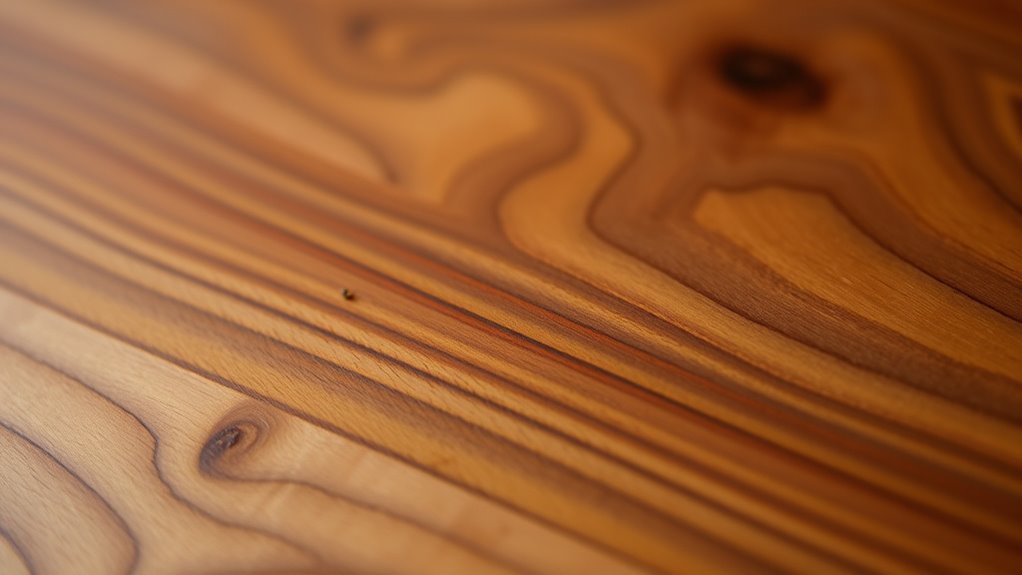To master stain matching, start by analyzing your wood’s grain pattern and natural color. Always test stain mixtures on scrap wood, adjusting until you match the original shade seamlessly. Work gradually, following the grain, and blend carefully along edges for flawless repair. Finish with clear or tinted sealers to match sheen and protect the surface. With patience and attention to detail, you’ll achieve professional results—there’s more to discover for perfect wood repairs.
Key Takeaways
- Test stain mixtures on scrap wood to achieve an exact color match before applying to the repair area.
- Match the stain’s opacity and grain direction to seamlessly blend repairs with existing wood.
- Use thin, gradual coats and blend along the grain for natural-looking repairs.
- Employ tinted sealers or touch-up pens to refine color and improve blending.
- Consider environmental factors like humidity and lighting to ensure consistent stain drying and color accuracy.
Understanding Your Wood and Its Unique Grain Pattern

Understanding your wood and its unique grain pattern is essential for achieving seamless repairs. The grain pattern influences how stain absorbs and reflects light, affecting the final look. Wood characteristics such as species, density, and porosity determine how it reacts to staining and finishing. For example, oak has a prominent grain that highlights texture, while maple’s tight grain results in a smoother appearance. Recognizing these traits helps you choose the right stain and application technique. Study the grain pattern closely before repairing; note the direction, width, and natural variations. This awareness allows you to match your repair seamlessly, ensuring the new finish blends naturally with the existing wood. Understanding wood properties is crucial for selecting the appropriate stain and achieving a cohesive look. Mastering these details gives you control over the final appearance of your project.
Selecting the Right Stain Color and Finish

Choosing the right stain color and finish is key to seamless wood repairs. You need to match stain shades carefully, pick finishes suited for the wood type, and always test on a hidden spot first. These steps help make certain your repair blends perfectly with the existing surface. Incorporating proper maintenance practices can also extend the life and appearance of your wood surfaces, ensuring your repairs stand the test of time.
Matching Stain Shades
Matching stain shades begins with carefully evaluating the existing wood’s color and grain pattern. Observe how the wood grain interacts with light and note any color variations. This helps determine the closest stain shade to blend seamlessly. Consider the stain opacity—whether a transparent or semi-transparent stain works best—since it affects how much of the original wood shows through. A more opaque stain can mask wood grain details, while a lighter, transparent stain enhances them. Test small samples on scrap wood with similar grain and color to see how they match under different lighting conditions. By paying close attention to the wood’s natural characteristics and stain opacity, you’ll select a shade that blends smoothly and maintains the wood’s authentic appearance. Additionally, understanding wood grain patterns can greatly improve your ability to match stains effectively.
Choosing Appropriate Finishes
Selecting the right finish is vital once you’ve identified the appropriate stain color. Your choice impacts the wood grain’s appearance and how well the repair blends with the existing surface. A glossy finish highlights the grain and adds shine, while a matte finish offers a softer, more natural look. Consider the environment—high-traffic areas benefit from a durable finish that resists scratches and wear. Finish durability varies depending on the type of product you choose, so opt for one suited to your needs. Keep in mind that some finishes enhance the wood grain more than others, influencing the overall aesthetic. Choosing the correct finish ensures your repair maintains its beauty and withstands daily use over time. For optimal results, consider the type of finish that best matches the existing surface and usage conditions.
Testing Before Application
Before applying your stain and finish, it’s essential to test them on a small, inconspicuous area of the wood. This step helps you preview how the stain interacts with the wood grain and guarantees the color matches your expectations. By doing so, you avoid surprises once the entire piece is treated. Pay attention to how the stain enhances or alters the wood grain, as this affects the overall look. Also, test the stain’s durability by applying the finish over the stained area to see how well it resists wear and fading. This initial test provides insight into color accuracy and how the finish will protect the wood long-term. Additionally, understanding emotional support can help you stay patient and confident throughout the staining process. Taking these precautions ensures a seamless, professional-looking repair that blends perfectly with the existing wood.
Testing Stain Mixtures on Scrap Wood

Start by choosing scrap wood that closely matches your project, as different types can affect stain results. Mix your stain in small ratios to see how color changes with varying amounts. Then, compare the color outcomes to find the perfect match before applying it to your repair. Additionally, testing on scrap wood helps prevent costly mistakes and ensures a seamless repair process. Local resources can provide guidance on selecting the right materials for your specific project.
Selecting Test Wood Types
When testing stain mixtures on scrap wood, choosing the right test samples is crucial to guarantee your results accurately match the final project. You want to select scrap wood that closely resembles your project’s wood grain and type, as these factors influence how the stain interacts. Hardwoods like oak or maple may absorb stain differently than softwoods like pine or cedar, affecting stain durability and appearance. Test on pieces with similar grain patterns to ensure the stain’s color, depth, and finish match your expectations. Using representative samples helps prevent surprises and saves time. Remember, the right test wood provides a realistic preview of how the stain will look and hold up on your actual project, making your repair seamless and professional.
Mixing Stain Ratios
Mixing stain ratios accurately is essential to achieving the perfect color match for your project. Start by blending small amounts of stain, adjusting ratios gradually to prevent overshooting your target shade. When testing on scrap wood, use consistent brush techniques—apply thin, even coats to gauge true color. Remember, stain drying affects how the color develops; give each coat time to dry fully before adding more. To refine your mix, consider these steps:
- Mix initial ratios in small containers for easy adjustments.
- Record each mixture’s proportions for future reference.
- Use consistent brush techniques to ensure uniformity.
- Wait for stain to dry completely before evaluating color accuracy.
- Be aware that exfoliation from glycolic acid can improve the surface texture, making color matching more precise.
This process helps you fine-tune your stain mixture, ensuring a seamless color match during your repair.
Analyzing Color Results
To accurately analyze your stain mixtures, it’s important to compare the test results against your desired color while the stain is still wet, as color can change as it dries. Pay close attention to color consistency across different areas of the scrap wood to confirm uniformity. Keep lighting conditions consistent when evaluating the results, since varying light can alter how the color appears. Natural daylight is ideal, but if using artificial lighting, use the same setup each time. Take notes on the color’s hue, depth, and sheen while the stain is fresh. This immediate comparison helps you make precise adjustments to your stain mixture, confirming a perfect match before applying it to your project. Additionally, understanding automation in business can help streamline the process of testing and adjusting stain formulations for optimal results.
Techniques for Blending Repairs Seamlessly

Achieving a seamless repair requires carefully blending the new stain with the surrounding wood, ensuring the color shift is natural and undetectable. Start by matching the stain to the wood’s grain direction, which influences how the color flows. Consider environmental factors like humidity and lighting, as they can affect how the stain dries and appears. To enhance blending:
Blend stains carefully along the grain, considering environment for flawless repair.
- Work in thin, gradual coats to control color build-up.
- Use a brush or cloth aligned with the grain to follow its natural flow.
- Wipe excess stain promptly to prevent uneven saturation.
- Allow proper drying time, adjusting for environmental conditions.
- Pay attention to wood finishing techniques that influence stain absorption and final appearance.
These steps help create a smooth gradual change, making the repair virtually invisible, especially when paying attention to grain direction and environmental factors.
Using Clear and Tinted Sealers to Match Sheen

Using clear and tinted sealers is essential for matching the sheen of the repaired area to the rest of the wood surface. Sealers help even out the gloss level, whether the wood has a high-gloss or matte finish. Tinted sealers can also enhance the wood grain, making the repair blend seamlessly. When choosing a sealer, consider stain durability; a durable sealer protects the repair from moisture and wear, preserving the match over time. Applying a clear sealer over the stain allows the natural sheen to show through, while tinted sealers can add depth and color to match the surrounding finish. Proper sealing ensures your repair maintains its appearance and withstands daily use without loss of sheen or integrity.
Applying Finishing Touches for a Flawless Look

Once you’ve applied your sealer and the repair area looks seamless, it’s time to add the finishing touches to achieve a flawless look. Focus on enhancing the wood grain and ensuring the finish’s durability. Here are key steps:
After sealing, refine the finish with light sanding, staining, and a clear topcoat for a flawless, durable look.
- Lightly sand the area with fine-grit paper to smooth out any uneven spots and reveal the wood grain.
- Use a matching stain or touch-up pen to refine the color, blending it with the surrounding wood.
- Apply a clear topcoat or polyurethane to protect the repair, boosting finish durability and gloss.
- Use a soft cloth to gently buff the surface, ensuring the repair seamlessly integrates with the original finish.
- For added protection, consider using a high-quality sealant designed for wood repairs, which can further enhance longevity and appearance.
These steps help you attain a natural appearance while maintaining long-lasting results.
Common Mistakes to Avoid When Stain-Matching

When stain-matching, it’s easy to make mistakes that can stand out and ruin the repair. One common mistake is over-sanding, which can remove too much of the existing finish and make color matching difficult. To avoid this, sand lightly and evenly, focusing only on the damaged area. Another mistake is rushing the process, leading to uneven color application and blotches. Prevent color blotch by applying stain gradually, building up layers carefully. Always test your stain on a hidden area first to see how it reacts with the wood. Using too much stain at once or not blending properly can also cause mismatched patches. Staying patient and attentive guarantees a seamless repair that blends naturally with the surrounding wood.
Frequently Asked Questions
How Long Does the Stain-Matching Process Typically Take?
The stain-matching process usually takes a few hours, but drying time can fluctuate based on the stain type and wood. You’ll want to check for color consistency before applying additional coats. Typically, you should wait at least 1-2 hours for each layer to dry thoroughly. Rushing the process might affect the final match, so patience ensures your repair blends seamlessly and looks natural.
Can Stain-Matching Be Done on Laminated or Engineered Wood Surfaces?
You can stain-match on laminated or engineered surfaces, but keep in mind laminate limitations. These surfaces often have a protective layer that resists stain absorption, making perfect matching tricky. Engineered wood, however, is usually easier since it resembles real wood and can take stain more readily. To get the best results, test the stain first and work carefully, knowing that some surfaces may need special prep or techniques.
Is It Necessary to Wear Protective Gear During Stain Repairs?
When you’re doing stain repairs, wearing protective gear is essential for safety precautions. It shields you from harmful fumes, skin irritation, and accidental spills. Always use gloves, goggles, and a mask to protect your eyes, skin, and lungs. Taking these precautions guarantees you stay safe while working with chemicals. So, yes, it’s necessary to wear protective gear during stain repairs to prevent health issues and ensure a safer working environment.
How Do Environmental Factors Affect Stain Adhesion and Color Matching?
You might be surprised how environmental factors influence your stain work. Moisture fluctuations cause wood to expand or contract, affecting how the stain adheres and looks over time. UV exposure can fade or alter the stain’s color, making matching tricky. By understanding these factors, you can better prepare your surface—perhaps using a sealant or choosing the right stain—to guarantee your finish stays beautiful and consistent despite changing conditions.
Are There Eco-Friendly Stain Options for Wood Repairs?
You can choose eco-friendly stains for your wood repairs by opting for natural finishes and plant-based formulas. These options are free from harmful chemicals, making them safer for the environment and your home. Eco-friendly stains often come in a variety of shades that match natural wood tones, ensuring your repair blends seamlessly. By selecting these products, you support sustainability while achieving a beautiful, durable finish on your wood projects.
Conclusion
Think of stain-matching like painting a masterpiece—you need to understand your palette and test your colors first. When I repaired a scratched table, experimenting with scrap wood saved me from mismatched spots. With patience and practice, you’ll find the secret sauce to seamless repairs. Just remember, each grain is like a fingerprint—unique and worth respecting. Master this, and your woodwork will look flawless, as if it’s always been part of the original design.









